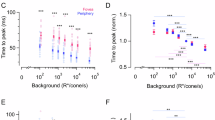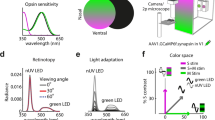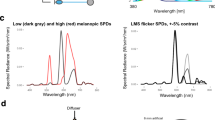Abstract
IN discussions of the several differences between the rods and the cones of the human retina it is usually stated that rods saturate and cones do not. When measurements are made of the intensity (ΔI) of an incremental flash that can just be detected on a steady background field of intensity I, the cones normally continue to obey Weber's law (ΔI/I = constant) at very high intensities when nearly all their pigment has been bleached away; but when only a very small fraction of rhodopsin, the rod pigment, has been bleached the incremental threshold for rods begins to rise more rapidly than is predicted by Weber's law. This saturation of the rod signal can be observed when, by careful choice of wavelengths and by exploitation of the directional selectivity of the cones, the rod response is followed to high intensities in normal observers1; or when measurements are made on rod monochromats, whose retinae completely, or almost completely, lack cone receptors2–4. Alpern, Rushton and Torii5 have suggested that it is bleaching that prevents saturation in the cones, for the receptor signal depends on the number of quanta actually absorbed and the latter quantity will tend to a limit as more and more pigment is bleached by steady background fields of increasing intensity. Cone mechanisms do saturate when intense, brief flashes are delivered to the unbleached retina5–6. We show here that the blue-sensitive receptors, which are normally thought to be cones, can be saturated by steady fields. In this respect they resemble the rods rather than the red- or green-sensitive cones.
This is a preview of subscription content, access via your institution
Access options
Subscribe to this journal
Receive 51 print issues and online access
$199.00 per year
only $3.90 per issue
Buy this article
- Purchase on SpringerLink
- Instant access to full article PDF
Prices may be subject to local taxes which are calculated during checkout
Similar content being viewed by others
References
Aguilar, M., and Stiles, W. S., Optica Acta, 1, 59–65 (1954).
Rushton, W. A. H., J. Physiol. Lond., 156, 193–205 (1961).
Blakemore, C. B., and Rushton, W. A. H., J. Physiol., Lond., 181, 629–640 (1965).
Sakitt, B., Vision Res., 16, 129–140 (1976).
Alpern, M., Rushton, W. A. H., and Torii, S., J. Physiol., Lond., 207, 463–475 (1970).
King-Smith, P. E., and Webb, J. R., Vision Res., 14, 421–429 (1974).
Wyszecki, G. W., and Stiles, W. S., Color Science, Concepts and Methods, Quantitative Data and Formulas (Wiley, New York, 1967).
Brindley, G. S., J. Physiol., Lond., 124, 400–408 (1954).
Krauskopf, J., and Mollon, J. D., J. Physiol., Lond., 219, 611–623 (1971).
Stiles, W. S., Coloquio sobre problemas Opticos de la Vision, 65–103 (Gen. Assembly int. Union pure appl. Physics, Madrid, 1953).
Cornsweet, T. N., Am. J. Psych., 75, 485–491 (1962).
Mollon, J. D., and Polden, P. G., Phil. Trans. R. Soc. B (in the press).
Pugh, E. N., J. Physiol. Lond., 257, 713–747 (1976).
Stiles, W. S., Proc. natn. Acad. Sci. U.S.A., 45, 100–114 (1959).
Rushton, W. A. H., J. Physiol., Lond., 220, 1–31P (1972).
Helmholtz, H., Optique Physiologique, II, 19 (Masson, Paris, 1867).
Purdy, D. M., Am. J. Psych., 43, 541–559 (1931).
Dowling, J. E., and Ripps, H., J. gen. Physiol., 56, 491–520 (1970).
Norren, D. V., and Padmos, P., Vision Res., 13, 1241–1254 (1973).
Author information
Authors and Affiliations
Rights and permissions
About this article
Cite this article
MOLLON, J., POLDEN, P. Saturation of a retinal cone mechanism. Nature 265, 243–246 (1977). https://doi.org/10.1038/265243a0
Received:
Accepted:
Issue Date:
DOI: https://doi.org/10.1038/265243a0



